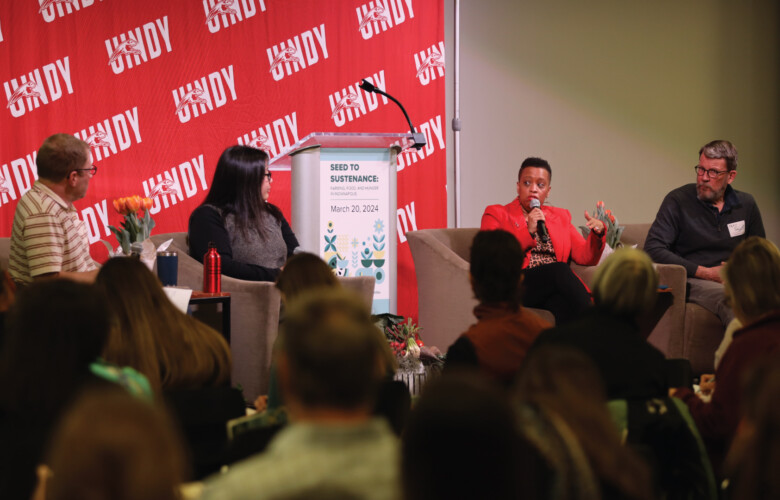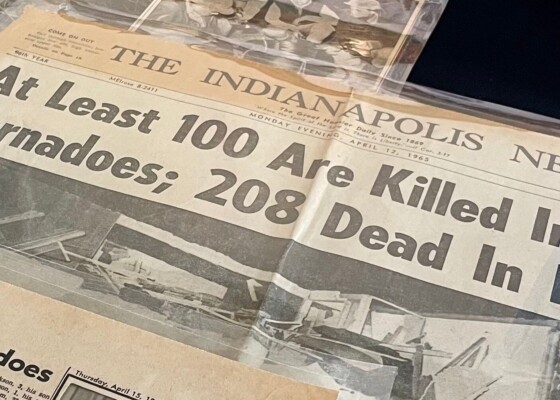Five Things We Learned during the 2024 Fairbanks Symposium: Seed to Sustenance
March 21, 2024Indiana Humanities and the University of Indianapolis hope our guests had an engaging and inspiring experience discussing the challenges and opportunities of equitably producing, distributing and consuming food in Indianapolis…
Indiana Humanities and the University of Indianapolis hope our guests had an engaging and inspiring experience discussing the challenges and opportunities of equitably producing, distributing and consuming food in Indianapolis at the 2024 Fairbanks Symposium.
Here are five things we learned for the discussions:
- Hunger is a growing problem. Hunger in Indiana has surpassed levels seen during the worst days of the COVID pandemic, Gleaners Food Bank of Indiana President and CEO Fred Glass noted during the symposium’s keynote session. Yes, hunger dropped to near-pre-pandemic levels for a time after the initial crisis subsided, but it recently surged at a pace not seen since the recession of 2008. Keynote INconversation partner Milele Kennedy, Indianapolis’ director of the Division of Community, Nutrition and Food Policy, said that, while food access issues persist, the heart of the hunger problem is less about access and more about poverty, which forces families to make difficult choices about how to manage limited finances. Glass pointed to four factors driving the area’s spiking poverty rate: skyrocketing rents, the increasing cost of groceries, an inflation rate that is outpacing wage growth, and the suspension of pandemic-related government supports. “Food insecurity is not about food,” Glass said. “It’s about poverty.”
- Our current food system is broken (or working perfectly for the wrong purposes). In the day’s first session, Kelsey Timmerman, the Indiana-based author of Where Am I Eating?, noted that, despite being an agricultural state, Indiana imports 90 percent of its food crops. Why? Connie Lee, director of operations for Central Indiana’s The Garden Table restaurants, said simply, “The food system is broken,” resulting in high costs for healthy foods and barriers to availability of food for the populations most at risk. Other speakers suggested that it’s the system’s purpose is that needs fixing. “The system isn’t broken,” Soul Food Project Indy Executive Director Danielle Guerin suggested. “It’s operating exactly the way its designed to.” Chris Baggott, founder of Tyner Pond Farm and co-founder of ClusterTruck, concurred, saying food access issues are fueled by food production, delivery and distribution systems that serve the purposes of massive companies rather than consumers.
- Food security and food sovereignty go hand-in-hand. People have a right not only to food, but to food that is aligned with their cultures, their lives and their needs. This growing notion of food sovereignty — the ability of people to have a say in what food is produced and distributed — takes discussions to a different level, ensuring not only that people are fed, but that they have power over what they are fed. Flanner House Director of Food Justice Candace Boyd Simmons said this should be a right that all people can exercise, whether they’re shopping at their local grocery store or seeking food supports in their community. Danielle Guerin said this combination of access and power are inseparable. “You can’t have food security without food sovereignty,” she said, and that means supplying people with food that is familiar and inherent to who they are. Various speakers alluded to giving people access to specific items — particular types of rice, for example, or specific kinds of vegetables, beans or other staples — and making sure they have a “voice at the table” when it comes to choosing what’s available. “Culturally relevant food … should be something everyone is entitled to,” Kennedy said.
- Disruption is coming (and it’s necessary). The systems that drive the production, distribution and purchase of our food are ripe for change, panelists suggested. Baggott sees large-scale disruption ahead, fueled by technology and a growing desire for locally produced food. “The idea of Kroger even existing 10 to 15 years from now blows my mind,” he said. “If you want local food, consumers, all you have to do is go online and say, ‘okra near me.’” Others see that kind of change needed at a local level, where Guerin and Chris Larson, director of environmental education at Paramount Schools of Excellence, noted that zoning and permitting rules can make it difficult to create and operate an urban farm. As we address these challenges, we also will have to face another: the higher cost of producing local, healthier foods. “In some ways, our food is probably too cheap,” Lee said. “How do we think about the need to grow quality food that treats people and the planet a certain way but do it affordably?”
- We have the power. Area residents who want to see improved access to local, healthy and culturally relevant food have the power to make that change happen. Boyd Simmons put it simply: “Demand that your grocery store offer foods that are relevant to you and your community,” she said. When someone asked how to do that without seeming antagonistic, a couple of the panelists responded quickly, saying, “Don’t be afraid to be antagonistic.” The greatest power, some suggested, lies in your spending. Where consumers spend their money, where they shop and where they contribute will play a big role in determining the future of farming, food and hunger in Indianapolis and beyond. “Your voice, your money,” Lee said “That’s your power.”
You can also view photos here from the event.
Additionally, if you would like to learn more about food-related resources and find ways to get involved, consider checking out these links:
Lastly, we’re always working to enhance the Fairbanks Symposium. Would you mind taking a moment to share your thoughts about your experience?



